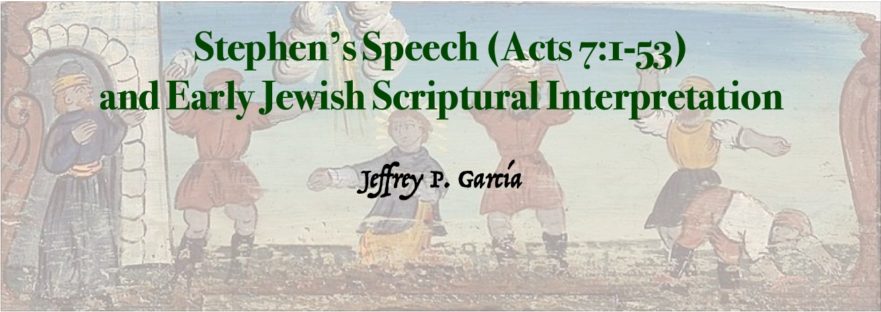How to cite this article: Jeffrey P. García, “Stephen’s Speech (Acts 7:1-53) and Early Jewish Scriptural Interpretation,” Jerusalem Perspective (2022) [https://www.jerusalemperspective.com/25184/].
The interest in early Jewish interpretation of scripture[23] has grown considerably with the publication of the Dead Sea Scrolls.[24] The interpretative traditions attested at Qumran redirected scholars’ attention afresh to the corpus of post-biblical Jewish literature compiled in the so-called Pseudepigrapha and Apocrypha. As studies have shown, the New Testament plays an important role in this discussion.[25] Indeed, examinations of scriptural interpretation in the New Testament provide examples of ancient Jewish interpretative methodology and known traditions that are paralleled in other Second Temple and rabbinic texts—as well as, previously unknown traditions. “Stephen’s Speech” (Acts 7:1-53) is a key example of both, namely, a witness to ancient Jewish exegetical style and a treasury of Second Temple interpretative traditions. While a full examination of the longest speech in the New Testament is beyond our scope here, we will highlight several verses that preserve ancient Jewish approaches to scripture and a complex of passages, towards the end, that preserve allusions to and exegesis of the Hebrew Scriptures.
Premium Members and Friends of JP must be signed in to view this content.
If you are not a Premium Member or Friend, please consider registering. Prices start at $5/month if paid annually, with other options for monthly and quarterly and more: Sign Up For Premium

- [1] Although in their present form the Testaments of the Patriarchs include Christian interpolations, the Testaments themselves were composed in the Second Temple period. When the Testaments include interpretations that are not explicitly Christian they may be presumed to have originated in the Second Temple period. ↩
- [2] James Kugel, Traditions of the Bible: A Guide to the Bible As It Was at the Start of the Common Era (Cambridge: Harvard UP, 1999), 264-265. ↩
- [3] Ibid. ↩
- [4] Ibid. ↩
- [5] Text from “Sefaria: A Living Library of Jewish Texts Online” (www.sefaria.org). Translation according to Midrash Rabbah (10 vols.; trans. H. Freedman; New York: Soncino, 1983), 1:315-316. ↩
- [6] I. Howard Marshall, “Acts,” in A Commentary on the New Testament Use of the Old Testament, eds. Carson and Beale (Baker Academic, 2007), 512-606. ↩
- [7] Qumran Cave 4, XVII: Parabiblical Texts, Part 3, eds. George Brooke, John Collins, Peter Flint et al., DJD XXII (Oxford: Clarendon Press, 1996), 1-24. ↩
- [8] H. F. D. Sparks, The Apocryphal Old Testament (OUP, 1984). ↩
- [9] Marshall, “Acts,” 559-561. ↩
- [10] Notably, Stephen’s Speech has conflated the only two accounts in Genesis where a field is purchased, the first in Hebron by Abraham and the second in Shechem by Jacob. ↩
- [11] Kugel, Traditions, 509; also, cf. Life of Moses 1:23. ↩
- [12] Text from “Sefaria: A Living Library of Jewish Texts Online” (www.sefaria.org). ↩
- [13] Translation from Steven D. Fraade, The Damascus Document: An Oxford Commentary on the Dead Sea Scrolls (Oxford: Oxford University Press, 2021), 61, esp. notes in 7:14, 15. ↩
- [14] RSV. ↩
- [15] Translation from Fraade, Damascus Document, 59. ↩
- [16] Ibid. ↩
- [17] These are also the only three occasions where the MT reads, “after other gods to serve them and worship them” (אַחֲרֵי אֱלֹהִים אֲחֵרִים לְעָבְדָם וּלְהִשְׁתַּחֲוֹת לָהֶם). ↩
- [18] David Flusser and R. Steven Notley, Jesus (Jerusalem: Magnes Press, 2001), 132, esp. n. 12. ↩
- [19] Flusser, Jesus, 139-140. ↩
- [20] See Flusser, Jesus, 139-140; idem, “Two Notes in the Midrash on 2 Sam. VII,” in Judaism and the Origins of Christianity (Jerusalem, Magnes Press, 1988), 88-101. ↩
- [21] Jacob Milgrom, ”The Temple Scroll,” BA 41/3 (2006): 115. ↩
- [22] Cf. Joseph Frankovic’s JP article, “Remember Shiloh!” ↩
- [23] The use of “scripture” and “scriptural,” rather than “Bible” and “biblical,” is intended to refer to texts that were authoritative—in varying degrees— to diverse ancient Jewish communities without presuming that the collection that we know as the Bible, Hebrew Bible, or Old Testament was static and in the form that exists now. ↩
- [24] See especially Moshe Bernstein, “The Contribution of the Qumran Discoveries to the History of Early Biblical Interpretation,” in The Idea of Biblical Interpretation: Essays in Honor of James L. Kugel (Leiden: Brill, 2004), 215-38. ↩
- [25] For example, R. Steven Notley’s “Jesus’ Hermeneutical Method in the Synagogue of Capernaum,” in Early Christianity and Intertextuality – Vol. 2: Exegetical Studies, eds. Craig Evans and Daniel Zacharias, LNTS 392 (London: Continuum, 2009), 46-59; also, idem and Jeffrey P. García, “Hebrew-Only Exegesis: A Philological Approach to Jesus’ Use of the Hebrew Bible,” in The Language Environment of First Century Judaea: Jerusalem Studies in the Synoptic Gospels—Volume Two, ed. Randall Buth and R. Steven Notley, JCP 26 (Leiden: Brill, 2014), 347-74; Lawrence H. Schiffman, “Biblical Exegesis in the Passion Narratives and in the Dead Sea Scrolls,” in Biblical Interpretation in Judaism and Early Christianity ed. Isaac Kalimi and Peter J. Haas (London: T&T Clark, 2006), 117–130; Serge Ruzer, Mapping the New Testament (Leiden, Brill 2007); Michael R. Whitenton, “Rewriting Abraham and Joseph: Acts 7:2-16 and Jewish Exegetical Traditions,” NT 54/2 (2012): 149-167; Dulcinea Boesenberg, “Retelling Moses’s Killing of the Egyptian: Acts 7 in Its Ancient Jewish Context,” BTB 48/3 (2018): 148-156, et. al. ↩



